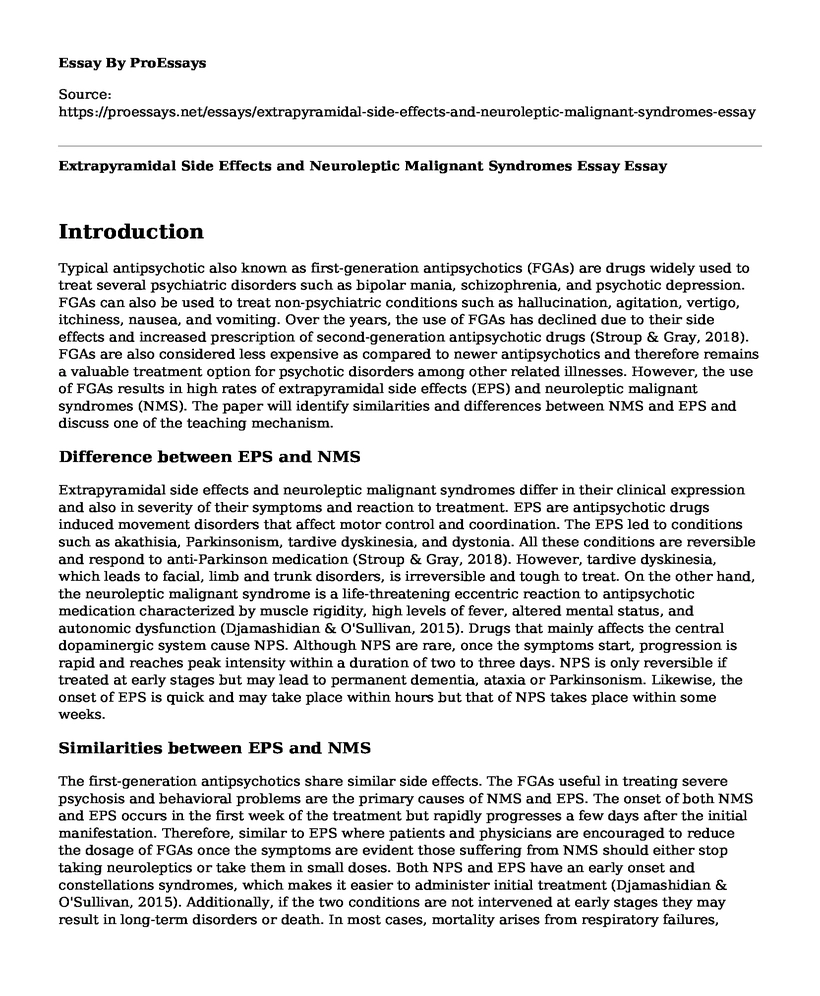Introduction
Typical antipsychotic also known as first-generation antipsychotics (FGAs) are drugs widely used to treat several psychiatric disorders such as bipolar mania, schizophrenia, and psychotic depression. FGAs can also be used to treat non-psychiatric conditions such as hallucination, agitation, vertigo, itchiness, nausea, and vomiting. Over the years, the use of FGAs has declined due to their side effects and increased prescription of second-generation antipsychotic drugs (Stroup & Gray, 2018). FGAs are also considered less expensive as compared to newer antipsychotics and therefore remains a valuable treatment option for psychotic disorders among other related illnesses. However, the use of FGAs results in high rates of extrapyramidal side effects (EPS) and neuroleptic malignant syndromes (NMS). The paper will identify similarities and differences between NMS and EPS and discuss one of the teaching mechanism.
Difference between EPS and NMS
Extrapyramidal side effects and neuroleptic malignant syndromes differ in their clinical expression and also in severity of their symptoms and reaction to treatment. EPS are antipsychotic drugs induced movement disorders that affect motor control and coordination. The EPS led to conditions such as akathisia, Parkinsonism, tardive dyskinesia, and dystonia. All these conditions are reversible and respond to anti-Parkinson medication (Stroup & Gray, 2018). However, tardive dyskinesia, which leads to facial, limb and trunk disorders, is irreversible and tough to treat. On the other hand, the neuroleptic malignant syndrome is a life-threatening eccentric reaction to antipsychotic medication characterized by muscle rigidity, high levels of fever, altered mental status, and autonomic dysfunction (Djamashidian & O'Sullivan, 2015). Drugs that mainly affects the central dopaminergic system cause NPS. Although NPS are rare, once the symptoms start, progression is rapid and reaches peak intensity within a duration of two to three days. NPS is only reversible if treated at early stages but may lead to permanent dementia, ataxia or Parkinsonism. Likewise, the onset of EPS is quick and may take place within hours but that of NPS takes place within some weeks.
Similarities between EPS and NMS
The first-generation antipsychotics share similar side effects. The FGAs useful in treating severe psychosis and behavioral problems are the primary causes of NMS and EPS. The onset of both NMS and EPS occurs in the first week of the treatment but rapidly progresses a few days after the initial manifestation. Therefore, similar to EPS where patients and physicians are encouraged to reduce the dosage of FGAs once the symptoms are evident those suffering from NMS should either stop taking neuroleptics or take them in small doses. Both NPS and EPS have an early onset and constellations syndromes, which makes it easier to administer initial treatment (Djamashidian & O'Sullivan, 2015). Additionally, if the two conditions are not intervened at early stages they may result in long-term disorders or death. In most cases, mortality arises from respiratory failures, cardiovascular collapse, suicide, or arrhythmias
Teaching Mechanism
Active learning mechanism is one of the most effective strategies for teaching especially among healthcare professionals who are required to demonstrate critical thinking, high level of communication skills and problem-solving abilities (Ranieri, 2015). Health practitioners should acquire valuable qualities and skills to enable them to evaluate analyze, synthesize and apply every information to resolve and prevent drug-related problems. Therefore, active learning would engage learners in activities, which requires them to reflect widely on learned ideas and ways to apply them in real life.
Conclusion
In conclusion, EPS and NMS are some of the disorders widely associated with antipsychotics. The conditions are acute and affect people of all ages. However, females and elderly are at higher risks of NMS and NMS as compared to their male colleagues and youths. Early signs of NMS and EPS should be taken seriously to avoid long-term and irreversible disorders. Lastly, patients should also take precaution by retaining correct electrolyte imbalance and maintaining their hydration levels.
References
Djamashidian, A., & O'Sullivan, S. S. (2015). Neuroleptic malignant syndrome. Medication-Induced Movement Disorders, 31.
Ranieri, M. (2015). Pharmacotherapy Casebook: A Patient-Focused Approach.
Stroup, T. S., & Gray, N. (2018). Management of common adverse effects of antipsychoticmedications. World Psychiatry, 17(3), 341-356.
Cite this page
Extrapyramidal Side Effects and Neuroleptic Malignant Syndromes Essay. (2022, Aug 04). Retrieved from https://proessays.net/essays/extrapyramidal-side-effects-and-neuroleptic-malignant-syndromes-essay
If you are the original author of this essay and no longer wish to have it published on the ProEssays website, please click below to request its removal:
- Nurture vs. Nurture and the Development of Human Personality Essay
- Statistics for the Behavioural Sciences Paper Example
- Adolescents, Young Adults and Suicide in the United States Essay
- Personality and the Risk of Cancer a 16-Year Follow-up Study of the GAZEL Cohort
- Research Paper on Refraining and Managing Stress in the 21st Century
- SLP Eval. & Manage. of Hyperkinetic Disorders Affecting Communication & Swallow - Essay Sample
- Essay Example on Norman's Human Environment: A Cognitive Psychologist's Discovery







